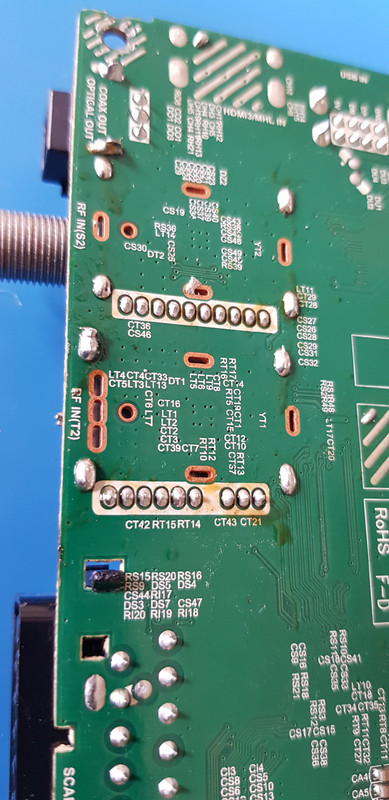- This topic has 30 replies, 17 voices, and was last updated 11 months ago by tillydog.
-
Electronics question – replacing TV tuner
-
nobbingsfordFull MemberPosted 11 months ago
I know I’m grasping at straws, but you never know…
I’m trying to fix my elderly neighbour’s TV. She accidentally snapped the aerial coax socket clean off it!
I’ve had it apart and found the socket was part of a tuner component, which I identified as a ‘cdt-9nt372-rf01’. I bought a replacement online and spent a couple of hours earlier today desoldering the knackered one and fitting the new one.
It looked like I’d done a decent job.
Powered up the TV, plugged in to our own aerial and initiated the Freeview auto-tune.
Nothing. Nadal. Zilch. 🙁
Is there something else I should have done to initialise or setup the new tuner, or have I simply done a shoddy job?
What can I try next?
Seems a shame to ditch a decent TV for the sake of a faulty tuner. Next step for her would just be a separate freeview box to plug in, I suppose.
I was so hoping I could fix it though. Very disappointed.
CougarFull MemberPosted 11 months agoNext step for her would just be a separate freeview box to plug in, I suppose.
‘s what I’d have done in the first place to be honest.
nobbingsfordFull MemberPosted 11 months agoYeah, I know, but I like fixing things! The new tuner was only 13 quid, so I thought I’d give it a go.
Some you win…
binmanFull MemberPosted 11 months agonobbingsford
Full Member
Yeah, I know, but I like fixing things! The new tuner was only 13 quid, so I thought I’d give it a go.
Some you win…
Good effort for trying!
cogglepinFull MemberPosted 11 months agoOn some TVs it asks when retuning if you want air or cable, you need to select air. Other than that the only other thing to select is digital/ Freeview.
zilog6128Full MemberPosted 11 months agoWithout having seen any pics, would you not have been better off just trying to repair/replace the socket? Or was the original tuner unit literally snapped in half?
squirrelkingFree MemberPosted 11 months agoHave you checked for continuity where there shouldn’t be any? Or none where there should?
nobbingsfordFull MemberPosted 11 months agoYeah, I did. Continuity between everything that’s connected to the outer shield. Various resistances measured between the 9 smaller pins (I.e. no shorts). Well, I measured between adjacent pins at least.
I thought my soldering looked ok.
The board as it came out, with knackered tuner:
And the new one fitted:
BruceFull MemberPosted 11 months agoHas the pcb got tracks on the top side, if so the holes might be through plated and the can be easily damaged when the old component is removed?
nobbingsfordFull MemberPosted 11 months ago@Bruce, it could be that, though I’m reasonably confident I didn’t damage anything during removal of the old component.
Now on the hunt for a good value Freeview box…
woody2000Full MemberPosted 11 months agoIs it possible she damaged the aerial cable when she snapped the socket off the board? Maybe your bit is perfect!
Edit – ignore me, I notice now you’ve tried your own cable!
fazziniFull MemberPosted 11 months agoNow on the hunt for a good value Freeview box…
I’ve got one in the caravan you can try first to make sure it all works before buying anything.
5labFull MemberPosted 11 months agoCould you solder the old connector back on and bodge an aerial lead directly onto it?
If the tuner bit is for the wrong county might it have limits as to its range which don’t work for the UK?
polyFree MemberPosted 11 months agoHave you tested with the Scart socket etc? Any possibility either she’s broken something else when she did the original damage or you’ve not connected something back up?
FlaperonFull MemberPosted 11 months agoDoes she have a satellite dish? Use the Freesat tuner instead.
RustyNissanPrairieFull MemberPosted 11 months agoAs per Bruce above – it’s a through hole tinned/plated hole. Solder sucker the joints clear and flux/rosin the shit out of it. Possibly put a small spacer under the tuner so the tuner body doesn’t wick the heat out of the join before the solder flows through.
Would be good to fix it.
soundninjaukFull MemberPosted 11 months agoShe accidentally snapped the aerial coax socket clean off it!
tillydogFree MemberPosted 11 months agoThe same module is in the schematic in this manual
Worth checking the voltages?
The nomenclature suggests it receives instructions via an I2C bus. AIUI, each I2C device has its own ID, so if you’ve changed it, you might need to tell the brains of the TV to go looking for a new device – There may be an engineering menu somewhere that facilitates this (or offers a hard reset/recovery option??)
Did you “take precautions” when doing the soldering (i.e. static control) – if not, it’s possible that whatever is at the other ends of the SCL & SDA lines has been zapped. If you have a ‘scope, it may be possible to detect activity on the SCL & SDA lines.
It seems your neighbour is not alone:
https://www.badcaps.net/forum/showthread.php?p=899836leffeboyFull MemberPosted 11 months agoAIUI, each I2C device has its own ID, so if you’ve changed it, you might need to tell the brains of the TV to go looking for a new device
Good call. I have no idea how that would work in mass produced electronics though.
tillydogFree MemberPosted 11 months agoI have no idea how that would work in mass produced electronics though.
Nor me…
Further ‘research’ suggests that the I2C address is relevant to a device type, rather than a specific device, so that may have been a red-herring.
I still think it’s worth trying to find an engineering menu so see if there are any tools or options there that might help.
leffeboyFull MemberPosted 11 months agoFurther ‘research’ suggests that the I2C address is relevant to a device type, rather than a specific device, so that may have been a red-herring
That would make a lot more sense. It’s 20yrs since I’ve designed using I2C and my memory just doesn’t go back that far
nobbingsfordFull MemberPosted 11 months agoWow – thanks all for the extra info. I admit I’ve not looked back at this thread since resigning myself to going down the external freeview box route!
I indeed did not take any static precautions I’m afraid, so may have buggered something up there.
It did cross my mind that maybe the TV would need a factory reset, which I did. No difference. If there’s some sort of engineering menu, it must only be accessible with a series of weird button presses or similar?
As for the other functions, it seems ok. HDMI input still works fine, for example.
I’m hoping I’ve not got a tuner programmed for another country. The part identified is identical and there’s no other markings on it to suggest it’s any different to the original.
This is (so far) one if the very few things I’ve not been able to fix. Its bugging me!
CougarFull MemberPosted 11 months agoI’m far from an expert so take this with a pinch of salt but, I think the risk from ESD is overstated. It’s something which was hammered into us in GCSE Electronics in the 1980s, and we used to handle boards like sodium in a thunderstorm.
In the intervening years I have never come across a failure where static was suspected as a cause, these days I reckon you’d have to be wearing wellington boots and a nylon onesie whilst rubbing a dehydrated cat on your head to fry modern hardware.
(Do not try this at home)
tillydogFree MemberPosted 11 months agoI’m hoping I’ve not got a tuner programmed for another country. The part identified is identical and there’s no other markings on it to suggest it’s any different to the original.
I’m pretty sure that the tuner will be told what to do by the main brain in the TV. You could possibly try changing the region of the TV to somewhere that has different frequency bands, and then changing it back again to see if this writes the correct data to the tuner. Check that there is 3.3 volts present where indicated on the schematic. If you have a scope, try looking for activity on the data lines (SCL & SDA).
Yes, any engineering menu will probably require standing on one leg while holding your left ear when you turn the set on, but google is your friend for this sort of thing. Often, the way in is fairly consistent for similar models from the same manufacturer.
captmorganFree MemberPosted 11 months agoHaving worked for/with Sun Microsystems in the 90’s & 00’s I often had hardware in my mitts that was worth multiples of my house, ESD was drummed into us from day one.
Today after some investigation I’d agree it’s unlikely to be the cause here, I believe that ESD is a thing but it’s much more likely to manafedt as shortening of components lifespan rather that instant catastrophic failures.
CougarFull MemberPosted 11 months agoI have the fragments of a memory around CMOS vs TTL and one being far more susceptible than the other, and we use the other more these days so it’s less of an issue (in so far as it ever was).
I may have made all that up in a fever dream. Much beyond resistors and LEDs and I’m out of my depth these days. I really should pick my Arduino back up.
tillydogFree MemberPosted 11 months agoI think the risk from ESD is overstated.
Do you feel lucky, punk?
The SCL and SDA lines go straight to the heart (pins 64 & 65 here):
(TTL pretty immune to ESD early CMOS very easy to kill. Modern MOS stuff still kill-able, but less likely ‘in circuit’ (such as populated computer boards). Arduino inputs are festooned with protective circuitry & quite difficult to kill.)
Anyway – looking at the schematic again, the satellite tuner is on the same bus as the RF tuner, so if the satellite tuner is working, then the bus is OK.
Is it a ‘Cello’ set? If so, try (in rapid succession):
[MENU] then 1 1 4 7
or
[MENU] 4 7 1 1 4 7
or
[SOURCE] 2 5 8 0to access the engineering menu.
Further rabbit-hole here:
Good luck 🙂
CougarFull MemberPosted 11 months agoTTL pretty immune to ESD early CMOS very easy to kill.
Yeah, I think that’s what was bubbling around in the back of what passes for my brain, thanks.
Individual chips may be susceptible I guess but… how many hobbyists are juggling surface-mount ICs?
nobbingsfordFull MemberPosted 11 months agoThanks so much for all the pointers, @tillydog. I now know that the main board in the TV is a TP.MS6486.PB711. It looks from various websites that the code to get into service mode is very likely to be MENU + 1 1 4 7 (though I’ve not found anything directly related to that board).
Now I just need to pluck up the courage to try it (and risk buggering up something else in the process)!
Is there likely to be some ‘reset tuner’ function in there?
Haven’t been able to find a service manual online for that board, so would be going in completely blind…
tillydogFree MemberPosted 11 months agoCheck that you’re getting 3.3V between pins 1 & 2 on the tuner before diving in. If not, there is a fault elsewhere.
There’s good chance that there will be some sort of diagnostic/self test option.
You must be logged in to reply to this topic.





